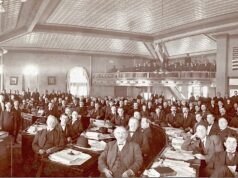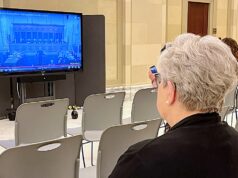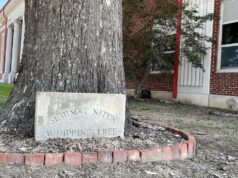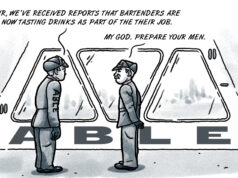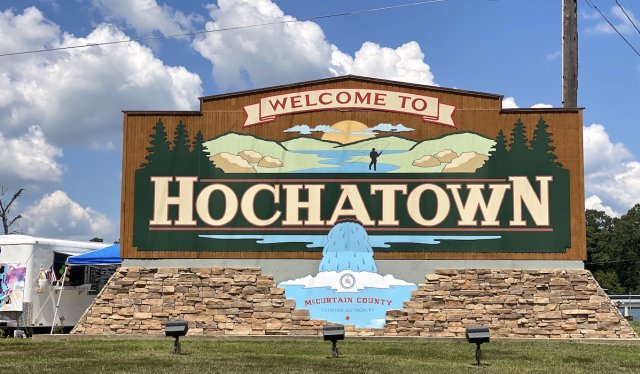

HOCHATOWN — Tommy McDaniel smiles slyly as he stands next to a plain brown bookcase at the back of the Hochatown Distilling Co. gift shop, on the north side of Hochatown, Oklahoma.
The distillery next door is filled with giant copper stills and wooden barrels that are just now starting to sweat out “the devil’s cut” as the whiskey ages and swells.
With an old-fashioned ringmaster’s flourish, McDaniel — who goes by the nickname “Blue” — pushes on the bookcase, and it glides open as if greased with liquor. Behind its swinging shelves, a secret speakeasy bar called the Tasting Room appears, stocked full with bottles of Hochatown Distilling’s bourbon and vodka.
McDaniel, along with his brothers — Mitch and Mark — and their friend Tater Jewell, founded Hochatown Distilling in 2015. It’s part of a small empire of businesses they and their families have started in the area, including a brewery, a couple of restaurants, a construction company and a cabin-rental business.
McDaniel is in high spirits. John Schneider of The Dukes of Hazzard fame was in town, strumming support for a local Republican on his guitar, and he’d come to the speakeasy the night before.
At the moment, the Tasting Room is empty, but by noon tourists will be wandering in for 3-ounce samples of the local hooch.
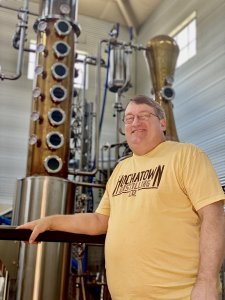
Twenty years ago, it would have been hard to believe this scene could exist. For most of its existence, Hochatown was barely a blip on the map in a wooded corner of southeast Oklahoma. But, in recent years, businesses such as the distillery have sprung up, bringing a new life to the once rural and isolated community.
Now Hochatown draws tourists from all over the region, who flock to the area for rolling green mountains, trout fishing and lake fun. Nearby Beavers Bend State Park is the most frequented state park in Oklahoma, with more than a million visitors each year. And this year alone, McCurtain County, where Hochatown is situated, has experienced a 145 percent increase in travel spending, compared to 2019, as city-dwellers have looked for outdoor options close to home during the COVID-19 pandemic.
Hochatown has evolved to accommodate this influx of attention. Once a Choctaw settlement and a bootlegger’s paradise, it is now a funky hamlet full of saloons and children’s parks, wineries and Bigfoot souvenirs, breweries and burgers, high-end cabins and marijuana dispensaries.
But the town’s booming popularity has not been without complications. Hochatown remains unincorporated, so it lacks a sewer system, police and fire departments and other municipal services, making it costly and inconvenient to run businesses. Most locals believe the town needs to incorporate, but heated debates rage about how to go about doing so.
Hochatown has been through many incarnations in the course of its history, and the steps it takes next will be key to securing its future.
Hochatime history
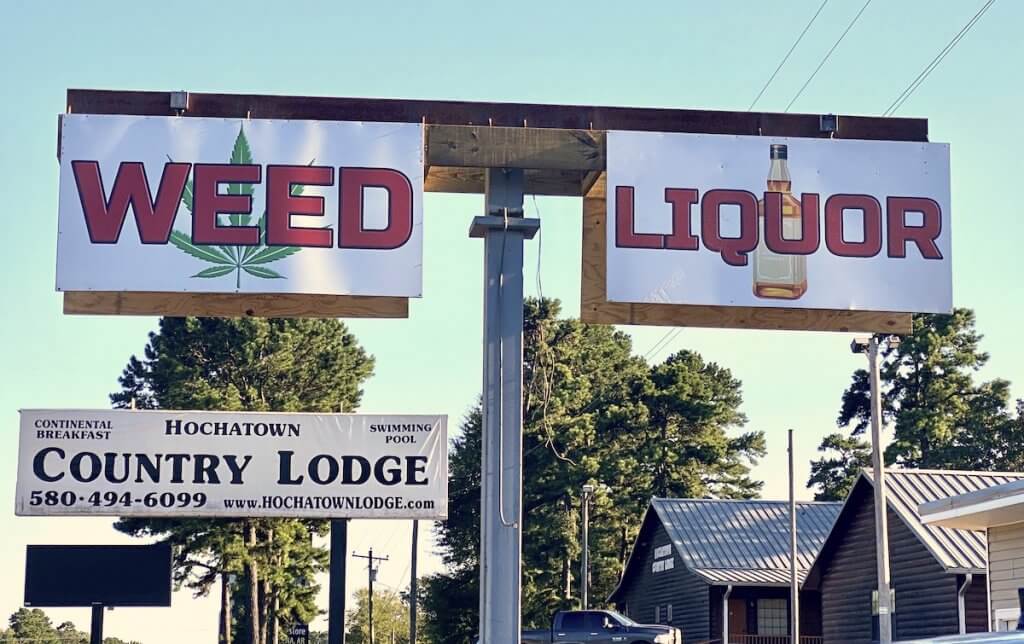
Hochatown has always been a place that has had to adapt to the forces of history. It hasn’t even stayed in the same spot.
Today, Hochatown is situated along U.S. Highway 259, but it has only been there since the 1960s, when it was moved to make way for the federal government’s construction of Broken Bow Lake.
Some of original buildings were relocated, including the church, and the graveyard was also moved to the new location. Several homes and buildings remain to this day under the waters of Broken Bow Lake.
The original Hochatown was a Choctaw settlement in what is now the Hochatown Valley, on the east side of the Mountain Fork River — an unspoiled paradise of plentiful wildlife, fertile soils and clear-running waters.
Small groups of Choctaw began moving to the area under the leadership of Choctaw District Chief Greenwood LeFlore in the 1820s, after the area was given to the tribe by the Treaty of Doak’s Stand but before the mass forced migration that followed the signing of the Treaty of Dancing Rabbit Creek and the Indian Removal Act of 1830.
According to Kenny Sivard, president of the McCurtain County Historical Society and member of the board of directors for the Oklahoma Historical Society, LeFlore contracted with brothers Josiah and William Doaks in 1824 to start Doaksville, the only trading post in the new territory, about an hour’s drive from modern-day Hochatown.
It wasn’t easy going at first. Neither the Doaks nor LeFlore anticipated how difficult trading and getting supplies would be. But in the years that followed, Fort Towson was established, and the area became a place where historical currents converged. The community now known as Hochatown formed in the midst of these changes.

Sivard likes to highlight a man named Peter Conser who was born in Hochatown in 1853. His mother was a full-blood Choctaw, and his father was an errant trader who could have been French or Swiss (the family name was originally Consieur), but no one really knows where he was from.
“That gives a glimpse into how unique that Hochatown history is because it was a commerce crossroads,” Sivard said. “You’ve got these two massively different worlds pulled in together with European trappers and traders working in Indian Territory and trading in Indian Territory. It’s not something that history really gets into.”
Though the federal government had promised that Indian Territory would be a permanent home for the Native Americans displaced through forced removal, the land was rich in natural resources and was seen as lucrative to railroad companies and others. After the neighboring Oklahoma Territory opened to white settlement in the late 19th century — and after Congress declined a petition from some Indian Territory citizens to create their own State of Sequoyah — the Curtis Act of 1898 made residents of Indian Territory subject to federal law. The two territories were combined by the Oklahoma Enabling Act of 1906, and the state of Oklahoma became official in 1907.
Hochatown was rich in natural resources, and by the early 1900s the Choctaw Timber and Coal Company helped transform the sleepy little village into a thriving timber town, complete with its own post office, trading post and railroad spur, according to the Oklahoma Historical Society.
“Everything was lumber down here,” Sivard said. “There’s not a single town in McCurtain County that wasn’t touched by timber.”
But eventually the lumber boom days slowed, and in the 1920s alcohol prohibition became federal law. Around the same time, the bottom dropped out of corn and cotton, leaving Hochatown’s farmers with an abundance of the crops. When you have plenty of corn and clean water, you also have a recipe for another profitable business: bootlegging.
Bootlegging and Bigfoot

In the 1930s, The Daily Oklahoman published an article declaring Hochatown “the moonshine capital of Oklahoma.”
“The whole area was inundated with moonshine,” Sivard said.
According to one local legend, Hochatown got its name from its bootlegging era: “hooch town.” (Sivard says the name more likely came from “a family of Choctaws named Hocha, sometimes referred to as the Hocha clan of Choctaws.”)
Prohibition did not end in Oklahoma until 1959, and Hochatown’s moonshine-driven economy thrived until then.
Now, Blue McDaniel notes that Hochatown Distilling was the first company to distill liquor legally in the state.
Ironically, McDaniel said he and his business partners originally wanted to open a moonshine operation.
“It’s illegal to make moonshine until you have a license. In order to have a license, you have to have a building and a still,” McDaniel said with a laugh. “So we had to set that all up and then we had to figure out how to make whisky. We drank bourbon for two years before we started figuring out our mash bill.”
That bootlegging history is also a draw for tourism. Locals like McDaniel speak about the illegal hooch history with a drop of pride in their voices, and the new distilleries, breweries and wineries pay homage to that drunken reputation. Some even whisper that the practice continues in the nooks and crannies around Hochatown and deep in the southeast Oklahoma woods.
Hochatown knows how to capitalize on its local legends, another of which is Bigfoot.
According to The Bigfoot Field Researchers Organization, which calls itself “the only scientific research organization exploring the Bigfoot/Sasquatch mystery,” Oklahoma has had 106 Bigfoot sightings, with the most recent reported in October. While nearby LeFlore County had the highest number of sightings, with 24, McCurtain County holds the second spot, with six.
But coming in second hasn’t stopped Hochatown from embracing that Sasquatch sensibility. Bigfoot is featured prominently in local shops, on billboards and in local artwork.
“I remember when I was a kid, that was a big deal to spin in Hochatown,” Sivard recalled. “And I think all little touristy towns in wooded areas of Oklahoma, they go through a Bigfoot phase, you know?”
Hocha gets hot
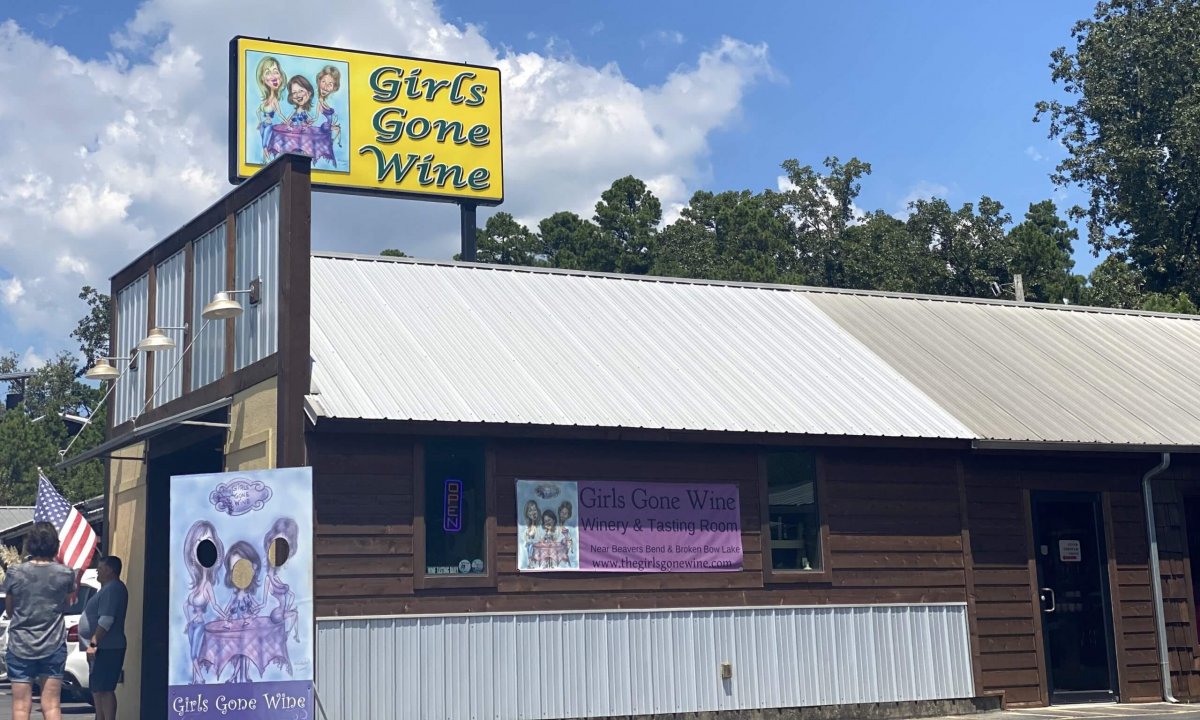
Despite the lure of bootlegging and Bigfoot, what really kicked off Hochatown’s latest phase was when three women from McCurtain County took a girls’ trip in 2005 to Dallas, where they visited shops and, more importantly, wineries.
Michelle Finch, Chandra Rickey and Rhonda Reed all lived and worked in the Broken Bow area.
“It was the craziest thing,” Finch said. “We went to Dallas and visited a winery, and Chandra said, ‘We should do this.’ I thought it was such a bad idea. When we opened on April 1, 2006, I thought we were located too far north. But, we did it for fun, and we said, ‘Hey, if it doesn’t work, then we could just drink all the wine.’”
At the time, Hochatown didn’t have many businesses that tourists would seek out. There were a couple of restaurants — Abendigo’s and Stephens Gap — but a winery in Hochatown was unheard of.
Finch, Rickey and Reed began setting up their winery operation. They source the grapes and their juices from various wineries, and then make the wine themselves using oak chips, granules or oak cubes. The oak chips or cubes are put in muslin bags that are submerged into the tank of wine. Some of the wines are aged this way for 14 days or more.
The trio opened their new winery and tasting room in a building that used to be a gas station and bait shop called Big Frank’s. The girls had no idea how big they would become.
“The locals, if they were really honest, thought we’d never make it. After we expanded after three years, that attitude changed to, ‘Well, if they can do it, anyone can do it,’” Finch laughed. “I mean, that sounds a little insulting, but I like that we inspired others to open businesses here, too.”
Finch, her husband and Rickey had all worked in the tourism industry, and they knew that although Broken Bow Lake and Beavers Bend State Park were drawing fishing and camping enthusiasts, more businesses were needed to make tourism in the area a success.
“What started to really change Hochatown into what it is today was when Girls Gone Wine went in,” said Sivard. “Then Grateful Head Pizza went in, and the place blew up because all of a sudden, now there are places to go up there — and hang out at that. It brought a different atmosphere.”
The McCurtain County Tourism Authority had already begun wooing north Texas tourists, promising a bucolic natural getaway. Suddenly, people who came for the state park and lake were finding new and cool places to hang out in Hochatown — restaurants, bars, shops, an escape room, a petting zoo — all with a certain distinctive personality.
The entrepreneurs Jessica Alkinwi and Kim Kennedy coined the name of their business, the clothing and lifestyle brand Hochatime, to describe this feeling: a mood that is country slow and relaxed.
“The idea of Hochatime is that when you come up here, you’re relaxing, escaping and trying to recharge,” Alkinwi said. “You get off your phone, get off the laptop and just really unplug.”
That Hochatime feeling has helped Hochatown become one of the biggest tax-generating areas in McCurtain County, and it has caused property values to skyrocket. It has also helped stem the flow of the youth drain from the area and bring locals back to the county.
“Right now, most of the business is from locals opening businesses, which is a source of pride to me,” said Finch. “My sister even returned to run one of the cabin management companies, and you hear story after story about keeping it local. But now, with so many cabins and so many businesses, it’s hard to find people to work locally. We need to start building in-town housing, and I know that’s not as sexy as vacation rentals.”
With growth, however, comes growing pains. Hochatown is reaching the limits of its existing infrastructure, and addressing the problem will require some big decisions.
Follow @NonDocMedia on:
The long road to incorporation

Living in an unincorporated area has its challenges. Most residences and businesses rely on septic systems, though many would like to have a legitimate sewer service. Sivard said the lack of sewer also opens up the dangers of polluting the creeks and rivers in the area if sewage isn’t dealt with properly.
Hochatown also doesn’t have an official fire or police service, which leads to higher insurance rates for homeowners and businesses.
Some locals believe the easiest fix would be to incorporate as part of Broken Bow. Others think Hochatown should become its own incorporated town, arguing that independence would be worth the staggering costs such a move would involve.
This conflict has been simmering for years. Broken Bow took measures to annex land from its northern neighbor in 1993, which spurred a legal and political battle, with Hochatown residents attempting to incorporate ahead of the annexation vote.
The push to incorporate reared up again in 2015 when the City of Broken Bow annexed a strip of land directly through the main thoroughfare of Hochatown. In response, some business owners and citizens in Hochatown filed a lawsuit in McCurtain County District Court, which led to an injunction preventing further action by Broken Bow until the case went to trial.
Other citizens signed a document consenting to the Broken Bow annexation.
The partners at Girls Gone Wine made a conscious effort to not be active in the politics around the debate, but the winery was one of the businesses that signed the consent to annex.
“We don’t want to push our beliefs on others, but what we desperately need in Hochatown is sewer. The quickest way to get that is to lock arms with Broken Bow,” Finch said. “This is just my opinion, but the quickest way to get fire, police and sewer is to align with a city that already has that and get all of that overnight.”
After signing the consent to annex, Girls Gone Wine and the other businesses received police service, trash service and fire protection, all of which dropped insurance costs. But they also had to accept the added pain of dealing with zoning and building rules.
“There were good and bad parts of it, sure,” Finch said. “But right now, we have urban problems in a very rural setting and no way to deal with those problems. We’ve got urban attitudes coming in and expecting fire and police services, and that just doesn’t exist right now.”
In July 2019, District Judge Jana Wallace voided Broken Bow’s annexation, and the businesses that had signed the consent lost the services they had gained.
But some, including the Hochatown Historical Association, considered the ruling a win in the fight to make Hochatown its own city.
“We are very excited about Judge Wallace’s ruling that Broken Bow’s efforts on their annexation to prevent Hochatown, Oklahoma, from being able to incorporate was illegal,” the association posted on its website. “As of now, we still must go through the process of incorporating which will take a little time and funding. Broken Bow is appealing this decision.”
If incorporated, Hochatown would be able to make decisions regarding zoning and municipal services and implement building and safety codes. It could also begin the process of establishing a tax base and collecting sales tax revenue.
“So, to throw a little personal opinion out there, the business owners and residents of Hochatown have not done enough to handle the growth,” Sivard said about the need for incorporation. “There’ve been a lot of people pop up with the businesses and pop up with some cabins, but not contribute to the overall infrastructure of that place.”
He said the burgeoning tourism industry requires additional public services.
“Now you’ve got a situation where you have the highest population in the whole county overnight on Memorial Day weekend, but you have no police force,” he continued. “You have no fire rescue. And the main thing is you have no public sewer system, and it has contributed greatly to the decay of the natural resources that grew that market.”
As an incorporated city, Hochatown could be eligible for state and federal grants to help with projects such as building a sewage system, but the whole process would take years, if not decades.
McDaniel and his partners are among those who want to see Hochatown become its own incorporated township.
He and his brother left McCurtain County in their youth but returned to open Hochatown Distilling and its partner businesses when they saw the growth opportunity the area now offers. He hopes that incorporation can sustain that growth.
McDaniel said he never expected to return to the impoverished area he grew up in, but his hometown is vastly different today.
“Before, everybody left here and never came back or they came back after they retired,” he said. “But once you’re in the mountains, it gets in your blood and it’s hard to get it out. I’m proud of what Hochatown is.”









